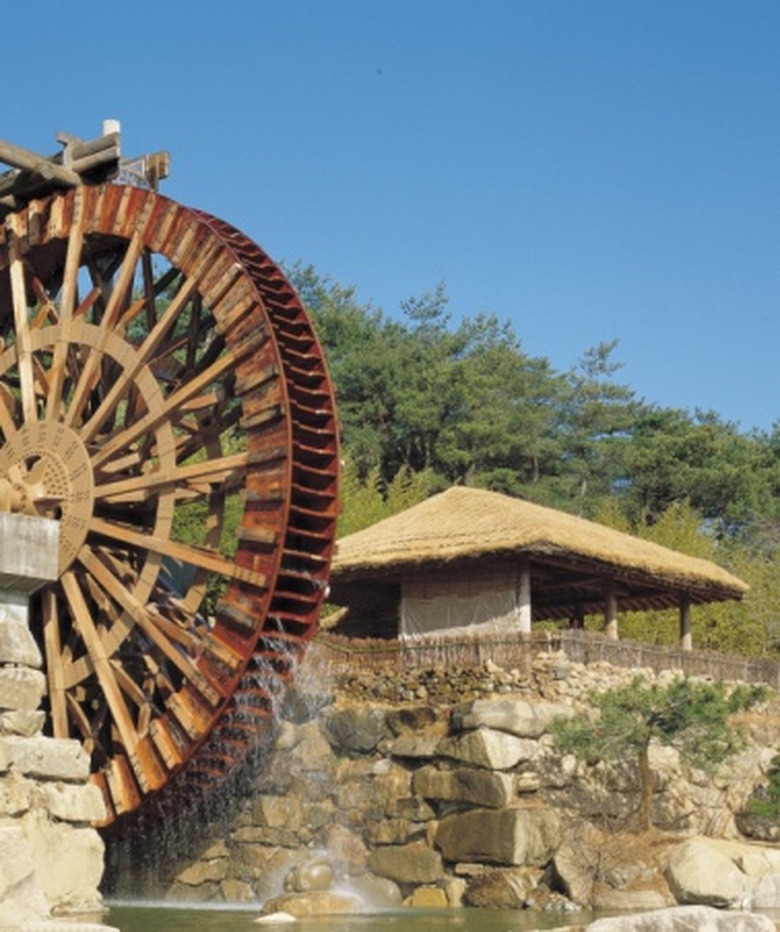What Are Water Mills Used For?
Water mills harness kinetic energy from moving bodies of water (usually rivers or streams) in order to drive machinery and generate electricity. The movement of the water drives the water wheel, which in turn powers a mechanical process within the mill itself. The most common mechanical process historically associated with water mills is grinding grains into flour. It was originally used for this purpose in ancient Greece and continues to be used this way today. Other common industrial applications of watermills include textile manufacturing and sawmills.
Gristmills
Gristmills
The most common use of water mills historically and in modern day developing countries is for grinding grains into flour. These are called gristmills, corn mills or flour mills. Early wheel design in ancient Greece and Rome employed horizontal paddles that were called Norse wheels. The paddle is attached via a shaft to a runner stone that grinds against a fixed "bed" stone. British and American gristmills work in a similar manner, but the wheel is mounted vertically.
Sawmills
Sawmills
The earliest known use of sawmills occurred in the eastern Roman Empire in the latter half of the third century and continued to be employed from the medieval period through industrialization. Hydro-powered sawmills were also common among the ancient Islamic world. As with other water mills, saw mills harness kinetic energy from moving water through a water wheel, only in this case the circular motion of the water wheel is translated to the back-and-forth motion of a saw blade through a rod known as a "pitman arm." Saw mills driven by hydro-power were capable of producing timber from logs more quickly and efficiently than manual labor. For this reason they continued to be common well into the American colonial period until the process became powered electrically.
Textile Mills
Textile Mills
The application of water mills to the production of textiles began in medieval France during the 11th century. These fulling mills used the motion of the water wheel to lift wooden hammers (known as fulling stocks) that beat down on cloth. Cotton mills used the rotating motion of the wheel to "card" raw cotton (breaking up and organizing raw clumps of cotton into wool) and for weaving cloth and finished wool.
Contemporary Uses
Contemporary Uses
Water mills are still used for processing grain throughout the developing world. They are particularly prevalent throughout rural India and Nepal. Although the availability of cheap electricity in the early 20th century rendered water mills virtually obsolete, some historic water mills continue to operate in the United States. Moreover, some water mills have been retro-fitted to produce clean, hydro-electric power in the United Kingdom. While these generate significantly less power than large hydro-electric plants, they have the advantage of not necessitating damming large rivers.
Cite This Article
MLA
Kwak, Patrick Stothers. "What Are Water Mills Used For?" sciencing.com, https://www.sciencing.com/water-mills-used-8153312/. 24 April 2017.
APA
Kwak, Patrick Stothers. (2017, April 24). What Are Water Mills Used For?. sciencing.com. Retrieved from https://www.sciencing.com/water-mills-used-8153312/
Chicago
Kwak, Patrick Stothers. What Are Water Mills Used For? last modified March 24, 2022. https://www.sciencing.com/water-mills-used-8153312/
